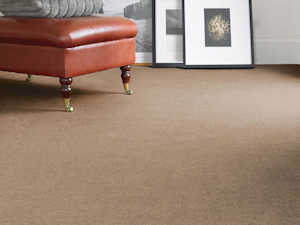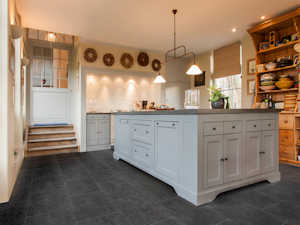Carpet & Colour Variations
Colour Matching
Carpet production occurs in batches, known as creels. Each batch typically yields between 500m2 to 3000m2 in a single width, depending on creel size. While the dyeing recipe remains consistent and is meticulously followed, color reproduction varies from batch to batch. However, production is always matched back to the original or master sample to ensure that the color remains within commercial tolerance.
This process is not an exact science; commercial tolerance is somewhat subjective and relies on the experienced judgment of the head dyer. A higher level of tolerance is necessary for blended colors (e.g., heathered carpets). For precise color matching, it is advisable to use a single width in installations requiring exact color consistency.
Please note that even carpets from the same batch may appear mismatched if the pile direction varies.
For further details, refer to the manufacturer’s recommendations.
Samples
Colours seen on screen may vary from actual production colours. and may not be from the same batch as current production. Therefore, they should serve as a guide rather than an exact color match.
We urge our customers to order samples pre-order to ensure satisfaction, samples you order via our website are sent direct from the manufacturer by post to yourself. This ensures you have samples from the latest production batch.
Shedding
Cut pile carpets tend to shed short fibers produced during the manufacturing process when spun yarn is cut for tuft formation. These fibers may accumulate on the surface, appearing as fluff. The extent of shedding depends on the yarn type and can be effectively removed by vacuum cleaning. It’s essential to understand that this excess fiber represents only a small fraction of the total fiber content in the carpet.
Pulled Loops
Pulled loops are specific to looped pile carpets, where one or more loops in the continuous pile are pulled through the primary backing. This typically occurs due to local conditions, such as sharp objects catching in a loop. Remedying pulled loops is as simple as trimming the affected end level with the rest of the pile. Leaving them unattended could lead to further loops being pulled, potentially developing into a ladder.
Sprouting
On occasion, a few tufts may protrude from the surface, standing higher than the rest of the pile. This may result from one end of the tuft being longer than the other, creating a J-shaped tuft instead of the typical V shape. Correcting this issue involves carefully scissor-trimming the affected tufts to match the pile’s level. Never attempt to pull them out.
Shading
Shading occurs when the carpet pile becomes crushed, flattened, or brushed in a direction different from its natural lie while in place. This results in varying light reflection angles, creating light and dark patches on the carpet. All pile fabrics can experience this phenomenon, but it may be more noticeable in plain carpets without heavy patterns or designs to disguise the shadows caused by pile pressure.
Static
Carpets do not generate static electricity, but like other household materials, they can store it. Static buildup typically occurs in dry environments and discharges when a person touches an electrically conductive object (e.g., door handles). The intensity of the static charge varies with individual, air humidity, and contact materials. Although static is commonly associated with synthetic materials due to their limited moisture retention, it can also occur with wool in very dry conditions. Preventive measures include introducing moisture into the room or using in situ carpet.
Fading on Wool
Wool carpets can fade over time due to exposure to ultraviolet (UV) light present in daylight. Direct sunlight accelerates this process, causing the carpet’s color to lighten or bleach, similar to the effects of sunlight on human hair. Protection measures should be applied to carpets exposed to such conditions, just as one would protect other furniture or fabrics. A complaint regarding fading is considered valid if it fails to meet the required shade standard specified in the British Standard BS1006 (1990) after testing.
Pile Reversal
Pile reversal, also known as shading or watermarking, occurs when the carpet pile or nap changes direction, reflecting light at different angles. This creates the appearance of light and dark patches. Pile reversal can affect all carpet constructions, from Axminster and Wilton to tufted, handwoven, and even coir matting. It can develop quickly after installation. Extensive research has been conducted to understand this phenomenon, but no conclusive cause or cure has been identified. It is not considered a manufacturing fault.
Indentations
Carpet can become indented when subjected to heavy point loads, such as furniture legs. Indentation recovery time depends on the load’s duration. Very heavy loads may result in extended recovery times. It’s important to note that not only the carpet pile but also the underlay can become indented. The use of cups under furniture legs can distribute the load, resulting in a larger area of less severe carpet indentation. Carpet manufacturers often have data on recovery from heavy static loads based on laboratory testing.
Flattening
Flattening occurs over time due to traffic, particularly in high-use areas. All pile fabrics will experience some degree of flattening, influenced by the level of traffic and the carpet’s construction, including tuft density, pile fiber, height, and weight.
Soiling
Carpet soiling typically results from local conditions, maintenance practices, or the lack thereof. Manufacturers cannot prevent soiling during use. Several types of soiling are common:
- Spillages: Liquids like soft drinks or hot beverages containing sugar can leave stains. Seek professional help for such stains.
- Shampoo Residue: Incorrect shampoo application can leave sticky soap residues that may lead to rapid re-soiling.
- Dust: Dust carried on drafts can soil carpets in various ways. Poorly fitted doors, skirting boards, or floorboards can allow dust to penetrate the carpet edges. Dark lines along skirting boards may suggest vacuum-drawn airborne dust through floorboard gaps. To prevent this, lining paper should be used in such installations.
Before Fittimg: Be aware of poorly fitting doors, skirting, or floorboards when taking carpet measurements. It is the customers’s responsibility to address these issues before installation.
Installations
We recommend following the guidelines laid out in BS5325:2001 (or the National Institute of Carpet Fitters installation manual) for carpet installations. Copies of these guidelines can be obtained from libraries or HMSO.







